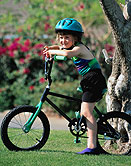 April 30, 2008
April 30, 2008
Tree-Lined Streets Associated With Lower Childhood Asthma Rates
WEDNESDAY, April 30 (HealthDay News) -- Young children who live in neighborhoods with lots of trees have lower rates of asthma than children who reside in areas with fewer trees, a new study finds.
Researchers looked at asthma rates among children aged 4 to 5, and asthma-related hospital admissions for children up to age 15, in 42 service districts of New York City. Asthma is the leading cause of hospital admission among children aged 15 and younger in the city.
The researchers compared the medical data to information about the number of trees in each of the districts, along with sources of pollution, population density, and racial and ethnic composition.
Nine percent of the young children in the study had asthma, and the city had an average of 613 trees per square kilometer. Asthma rates decreased by almost one-quarter for every standard deviation increase in tree density, equivalent to 343 trees per square kilometer, the study found. This pattern held true even after the researchers factored in sources of pollution, socioeconomic status and population density.
However, there was no association between tree density and asthma-related admissions to hospital among older children.
The results don't mean that tree density in a neighborhood is directly related to asthma rates among children, said the researchers, who added that trees may help reduce asthma rates by encouraging children to play outdoors more or by improving air quality.
The study was published online in the Journal of Epidemiology and Community Health.
The researchers noted that New York City is planning to plant 1 million extra trees by 2017, which could provide an opportunity to study exactly what impact tree density may have on asthma.
More information
The American Lung Association has more about childhood asthma.
-- Robert Preidt
SOURCE: BMJ Specialist Journals, news release, May 1, 2008
id=615032


